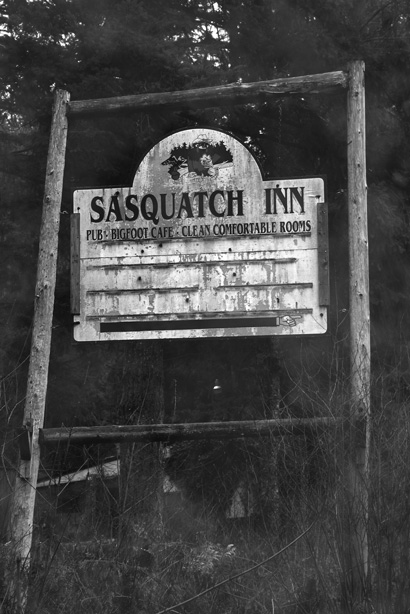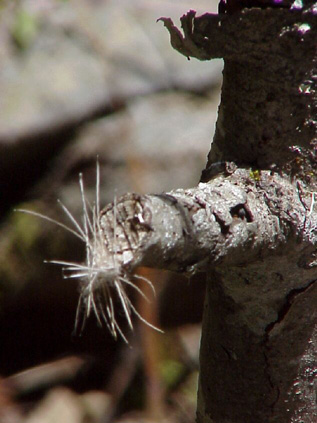Part III… Bigfoot sign
Posted by: Rick Noll on October 2nd, 2005
2. Sign.

No! Not this type of sign. This was take at the Historic Sasquatch Inn in BC, Canada on the way to see John Green at Harrison Hotsprings. As far as I can determine, no Sasquatch have really stayed here. All kidding aside though, absolutely no one can predict where a Bigfoot is or will be. But that is what I am working towards.
This kind of goes along with tracks but contains much more information behavioral wise. Here is where we try and find where further interaction with the environment is exhibited. Browsing, shelters or nest building, tool use, food processing preparation, vocalizations, hair and scat are some of the things fitting this topic of investigation.
Browsing deals with edible plant material, either for medicinal, processing or caloric reasons. Our area has an abundance of natural occurring, as well as abandoned fruiting flora. We look at berry fields for their fruiting times and locations. We look at sedges, nettles, lichen, fern fiddleheads and pine nuts. We check on insect nests and larva. We find areas where with just a little bit of water annelids come to the surface in great numbers. We are looking for food material that historically humans have utilized and those that local animals use. We also try and correlate all of these with current knowledge of other great apes.
We check on things that look like they have been made into shelters or nests from the local flora and geology. We check for indications of usage regularly when we do find things like this. We also note where another possible symbiotic life form exists; aid to hunting or searching like with coyotes and birds.
We look for objects indicating recent origin and that may be used as rudimentary tools, such as large stone crushers, sharp tree limb roots and reaching/digging sticks. Many may not be familiar with the last two items so I will explain them a little more.
Limbs coming out of trees get surrounded by the outside trunk as it grows over time. The limb root embedded can become dislodged through natural occurring fire, weather, disease and insect damage. These roots are very sharp and hard and can be used for a variety of jobs requiring something akin to a knife. I have actually found these sharp limb roots in skeletons of deer and elk while out investigating. Is this a tool? Who knows but if no one documents it, finding out may take a lot longer than if someone does.

While in the BFRO, I helped investigate Jerry Kelso’s sighting near Mt. Saint Helens, where he claims to have given chase after a Sasquatch, abandoning his wife and child in the car. He claimed it was after an elk with a club in it’s hand. We found an elk skeleton. The legs had been ripped off and the head and rack was found a hundred or so feet away. All the skin and hair was deposited about six feet away from the main find. Inside the ribcage was this sharp piece of wood. It sits beside me right now as I am writing this.

Did this statue, which Jerry Kelso most assuedly drove by many times, prompt his Bigfoot encounter or as Matt Moneymaker explains – did art imitate nature or is it the other way around?
Reaching stick usage can mean different things to different people and in different areas. These can be used simply to move something from point A to point B but they can also be used to pull things down from a height or up from being low. Some lichens that may be utilized by the Sasquatch can grow at substantial heights in precarious tree braches. As a digging stick, shoreline selfish is harvested much easier than by a hand without sharp long claws embedded in them.
The processing of food by something like a Bigfoot can be as simple as washing off natural occurring outside chemicals or more complicated like the rolling up of nettle leaves so that the stinging sections are on the inside or even the ingestion of other material (like clay soil or lichen) that counteracts toxins from possible fern rhizome ingestion or produces bacteria aiding in very starchy food breakdown. These have all been documented in other primates.
We sparingly broadcast sounds purported to be that of Bigfoot, hoping to elicit a response and possibly having the animal come closer to investigate the disturbance. We feel that when dealing with a primate, intelligence unsurpassed in the natural kingdom has to be taken into account. Will the sounds work more than once or twice in a given area? Do we burn the area out with human tom-foolery? Who knows but it is safer to be cautious and have all your tools at hand to record an encounter.

Scat is no longer collected by us. We document and photograph it and its location on site and identify it with literature on hand. Sometimes we open it up to determine what was being eaten. When dealing with primates, handling their scat can be very dangerous.
Unusual odors can sometimes lead to a stationary object but most of the time it doesn’t. We note the time and place where it occurs though. Surprisingly, mapping these smells fills out the picture developing better. I didn’t think it would, being subjective in its interpretation as it is.
About Rick Noll
Rick Noll has been actively searching for the Sasquatch since 1969 and continues his pursuit with extended field trips into the Pacific Northwest's most remote regions. Rick has worked with Peter Byrne, René Dahinden, Grover Krantz, John Green, Jeff Meldrum and the BFRO during all this. He helped with many documentaries on the subject including Animal X: The Skookum Expedition and Sasquatch: Legend Meets Science.










Holy Toledo man, the limb root in the ribs is really pretty darn ponderous.
Being that you said you’ve found them inside of other skeletons… the implications of that … wow.